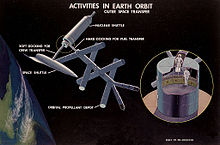 1970 artist's concept illustrating use of a Space Shuttle, Nuclear Shuttle, and Space Tug | |
| Program overview | |
|---|---|
| Country | United States |
| Organization | NASA Office of Manned Spaceflight |
| Manager | George Mueller |
| Purpose | Reusable, low-cost transportation to Earth orbit, cislunar and interplanetary space |
| Status | Failed to gain political support |
| Program history | |
| Launch site(s) | Kennedy Space Center |
| Vehicle information | |
| Uncrewed vehicle(s) | Space tug |
| Crewed vehicle(s) |
|

The Space Transportation System (STS), also known internally to NASA as the Integrated Program Plan (IPP),[1] was a proposed system of reusable crewed space vehicles envisioned in 1969 to support extended operations beyond the Apollo program (NASA appropriated the name for its Space Shuttle Program, the only component of the proposal to survive Congressional funding approval). The purpose of the system was two-fold: to reduce the cost of spaceflight by replacing the current method of launching capsules on expendable rockets with reusable spacecraft; and to support ambitious follow-on programs including permanent orbiting space stations around Earth and the Moon, and a human landing mission to Mars.
In February 1969, President Richard Nixon appointed a Space Task Group headed by Vice President Spiro Agnew to recommend human space projects beyond Apollo. The group responded in September with the outline of the STS, and three different program levels of effort culminating with a human Mars landing by 1983 at the earliest, and by the end of the twentieth century at the latest. The system's major components consisted of:
- A permanent space station module designed for 6 to 12 occupants, in a 270-nautical-mile (500 km) low Earth orbit, and as a permanent lunar orbit station. Modules could be combined in Earth orbit to create a 50 to 100 person permanent station.
- A chemically fueled Earth-to-orbit shuttle.
- A chemically fueled space tug to move crew and equipment between Earth orbits as high as geosynchronous orbit, which could be adapted as a lunar orbit-to-surface shuttle.
- A nuclear-powered shuttle or ferry using the NERVA engine, to move crew, spacecraft and supplies between low Earth orbit and lunar orbit, geosynchronous orbit, or to other planets in the solar system. A crew module derived from the space station module would be used to send humans to the Moon or Mars.
The tug and ferry vehicles would be of a modular design, allowing them to be clustered and/or staged for large payloads or interplanetary missions. The system would be supported by permanent Earth and lunar orbital propellant depots.[2] The Saturn V might still have been used as a heavy lift launch vehicle for the nuclear ferry and space station modules. A special "Mars Excursion Module" would be the only remaining vehicle necessary for a human Mars landing.
The STS was championed by NASA Administrator Thomas O. Paine until May 1969 and gained Agnew's enthusiastic support. However, as Apollo accomplished its objective of landing the first humans on the Moon, Nixon realized that political support for further crewed space activities was beginning to wane, and the Congress would be unwilling to provide funding for most of these extended activities. Based on this, Nixon rejected all parts of the program except the Space Shuttle, which inherited the STS name. Nixon accepted Paine's resignation in July 1970 and replaced him as administrator with James C. Fletcher.
As a result of funding constraints, Shuttle was significantly scaled back from its planned degree of reusability. The overall program scheduled was also delayed. The Shuttle first flew in 1981, and was retired in 2011.
A second part of the system, Space Station Freedom, was approved in the early 1980s and announced in 1984 by president Ronald Reagan. However, this also became politically unviable by 1993, and was replaced with the International Space Station (ISS), with substantial contribution by Russia. The ISS was completed in 2011.



